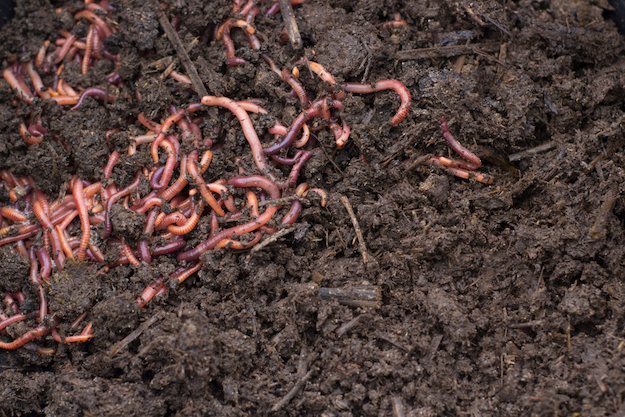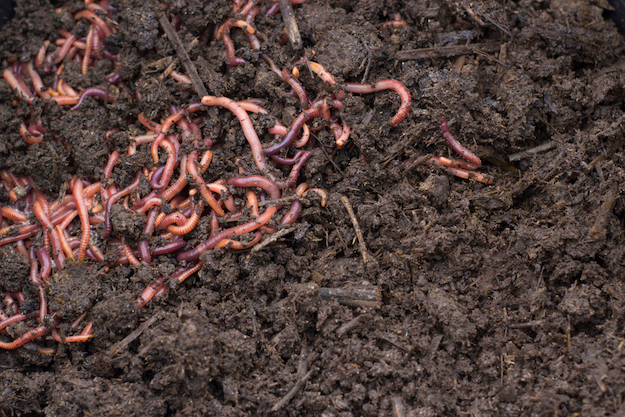The 6 Steps On How Vermicomposting Works

Materials Needed:
- Worm bin, wooden or plastic container, 8 to 12 inches deep by 1 square foot surface area for every pound of household food waste produced weekly. Plastic storage containers or old dresser drawers can work perfectly.
- Loosely fitting cover, dark plastic or burlap to allow good ventilation
- Drill
- Bricks or wooden blocks
- Moisture collection tray
- Bedding, such as shredded corrugated cardboard or paper (avoid shiny glossy inserts and the Sunday funnies), peat moss or commercial worm bedding
- Water
- One pound of redworms (Eisenia foetida or Lumbricus rubellus) for each half-pound of scraps you plan to compost weekly
- Nonfatty kitchen scraps, such as green leafy vegetable waste, leftover pasta, used coffee filters and grounds, tea bags, fine grit such as cornmeal and crushed dry egg shells. Yard debris, such as leaves and grass clippings will also work. Avoid meat, eggs, bread fruit, citrus, garlic and onion, oil, fat and grease, pet droppings, and dairy to prevent worm health and rodent issues.
Procedure
Step 1
Drill 8 to 12 quarter inch holes in the bottom of the chosen bin container. Set the container on bricks or wooden blocks for good air flow and drainage. Put a moisture collection tray underneath to catch the drips, which make good plant fertilizer.
Step 2
Fill a separate container with bedding material and add water until it just covers the bedding. Let it absorb the moisture for 2 to 24 hours. Squeeze out any remaining excess water. Fluff the materials.
Step 3
Fill the worm bin two-thirds full with the fluffed bedding material to help with moisture and air retention and give the worms living space.
Step 4
Scatter the redworms (Eisenia foetida) on top of the bedding. They will burrow in on their own. Keep the bin between 55 and 77 degrees Fahrenheit to keep your worms happy and healthy.
Step 5
Slowly spread a thin layer of gritty material, such as crushed eggshells or ground limestone, and vegetable scraps on top of the bedding. Cover the food waste with another thin layer of bedding. Gradually increase the food supply as your bin becomes more established. Feeding time is when your worms have composted all existing food supplies in the bin. Keep the bin loosely covered in a dark place. Secure the bin against any neighborhood cats using it as a litter box to avoid contaminating your worms food source.
Step 6
After regularly turning and feeding the worms for three to four months, the “castings” they leave as soil enrichment will be ready to harvest. Set the worm bin under a bright light so the light-sensitive worms will escape into the lower reaches of the bin and slowly remove layers of bedding with a sieve, returning any straggling worms to the bin. Replace the moist bedding and food scraps to allow your worms to start the composting process all over again. Use the rich, black compost as soil amendments for potted plants and in the garden.
Do you have your own worm farm business, or are you looking to start your own? Check out how to start a worm farm to learn about the industry and how easy it is to get started.
References
CalRecycle: Vermicomposting: Composting with Worms
Earthwormworks: Getting Started Vermicomposting
City of Thousand Oaks: Composting with Worms
International Crops Research Institute for the Semi-Arid Tropics
RecycleWorks: Worm Composting Basics
Los Angeles Department of Public Works: Worm Composting
University of Nebraska Extension in Lancaster County: Vermicomposting – Composting With Worms
University of California Agriculture and Natural Resources: Vermicomposting: Worms at Work
Cornell University Greenhouse Horticulture: Vermicompost is Putting Worms to Work
Washington State University Whatcom County Extension: Cheap and Easy Worm Bin
Related Content
Planet Natural: Using Worms
Beginning Famers: Worm Composting on a Large Scale: How it Works
Organic Consumers Association: Local Vermicomposting Company Works to Turn Garbage Into Cash
Michigan State University: Vermicomposting: Worms Eat My Garbage!
North Carolina Cooperative Extension: Vermicomposting
Cornell University: Waste Management Institute: Worm Composting Basics




